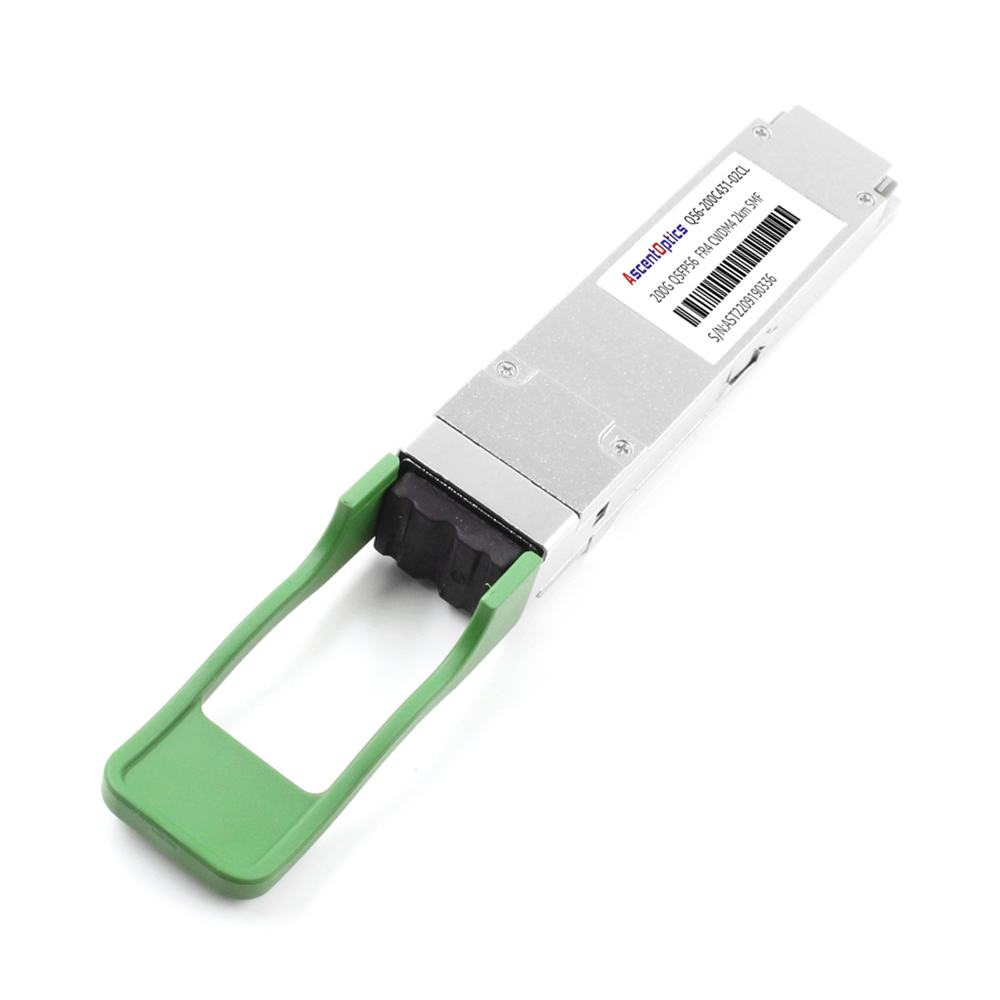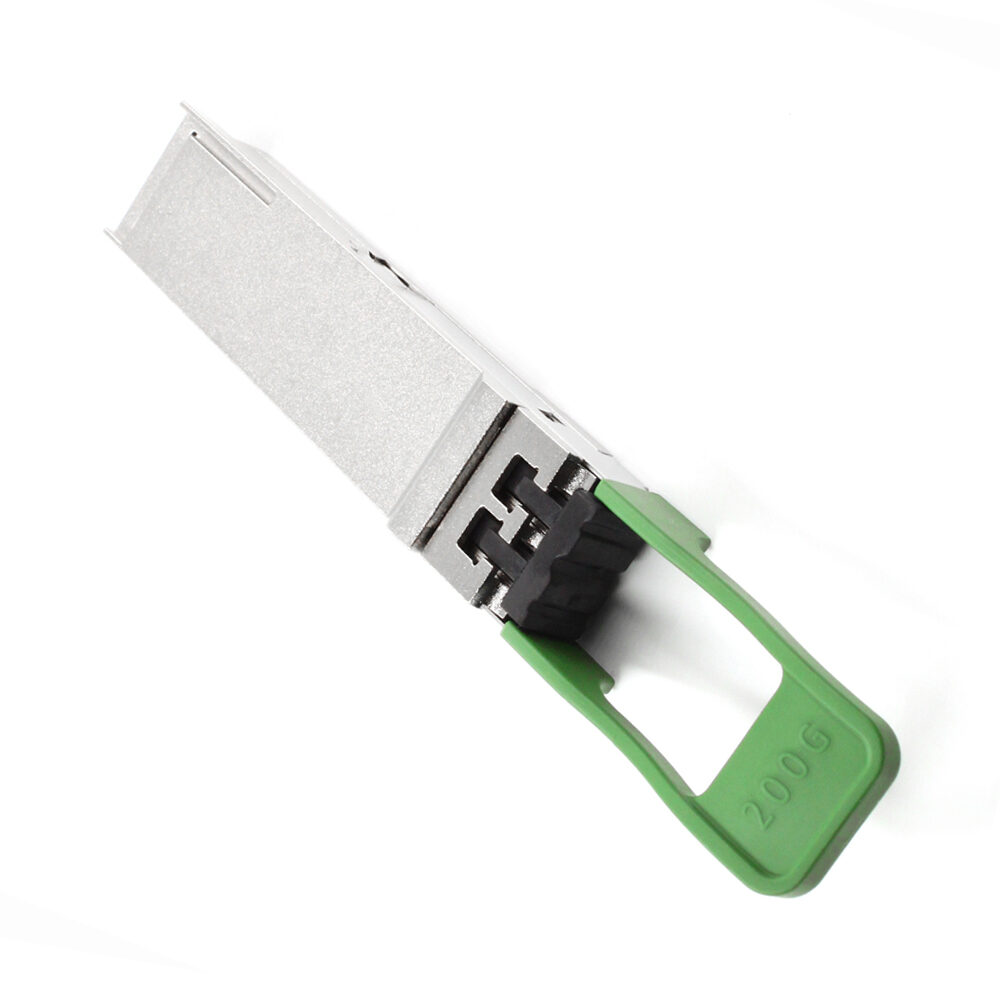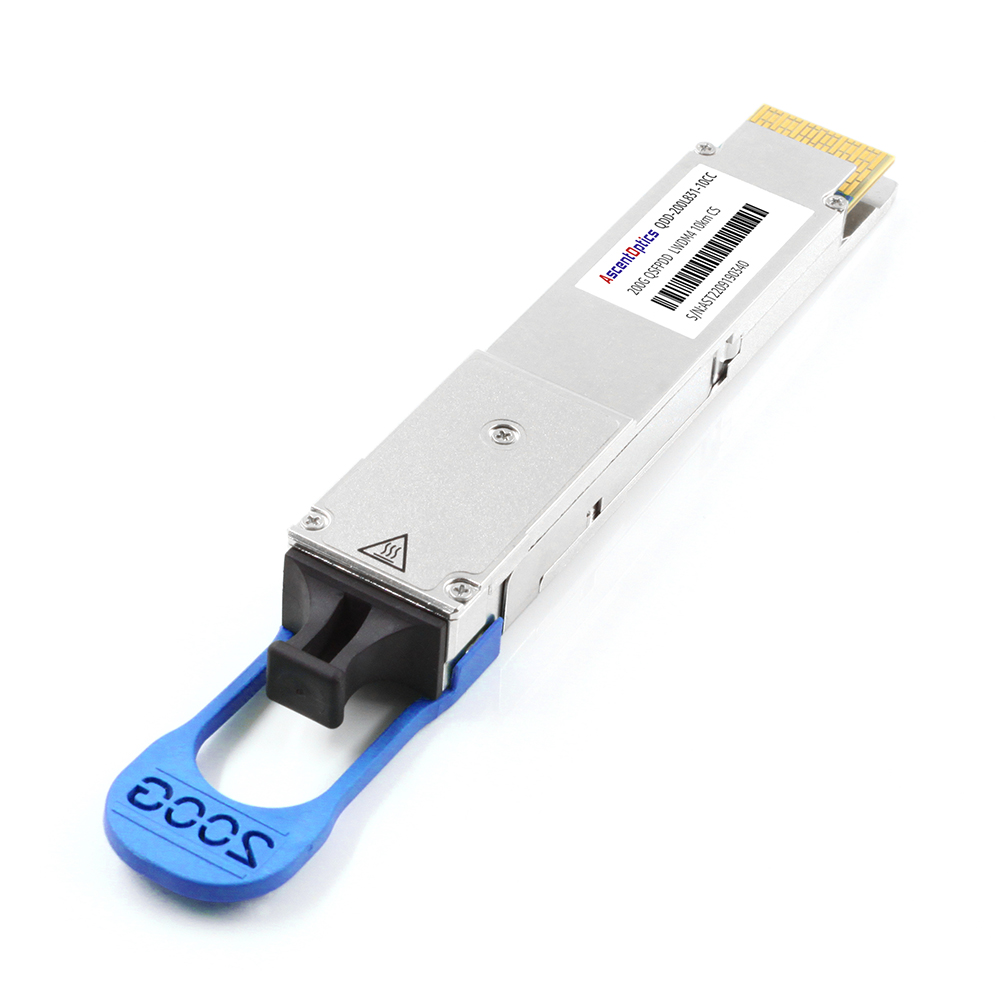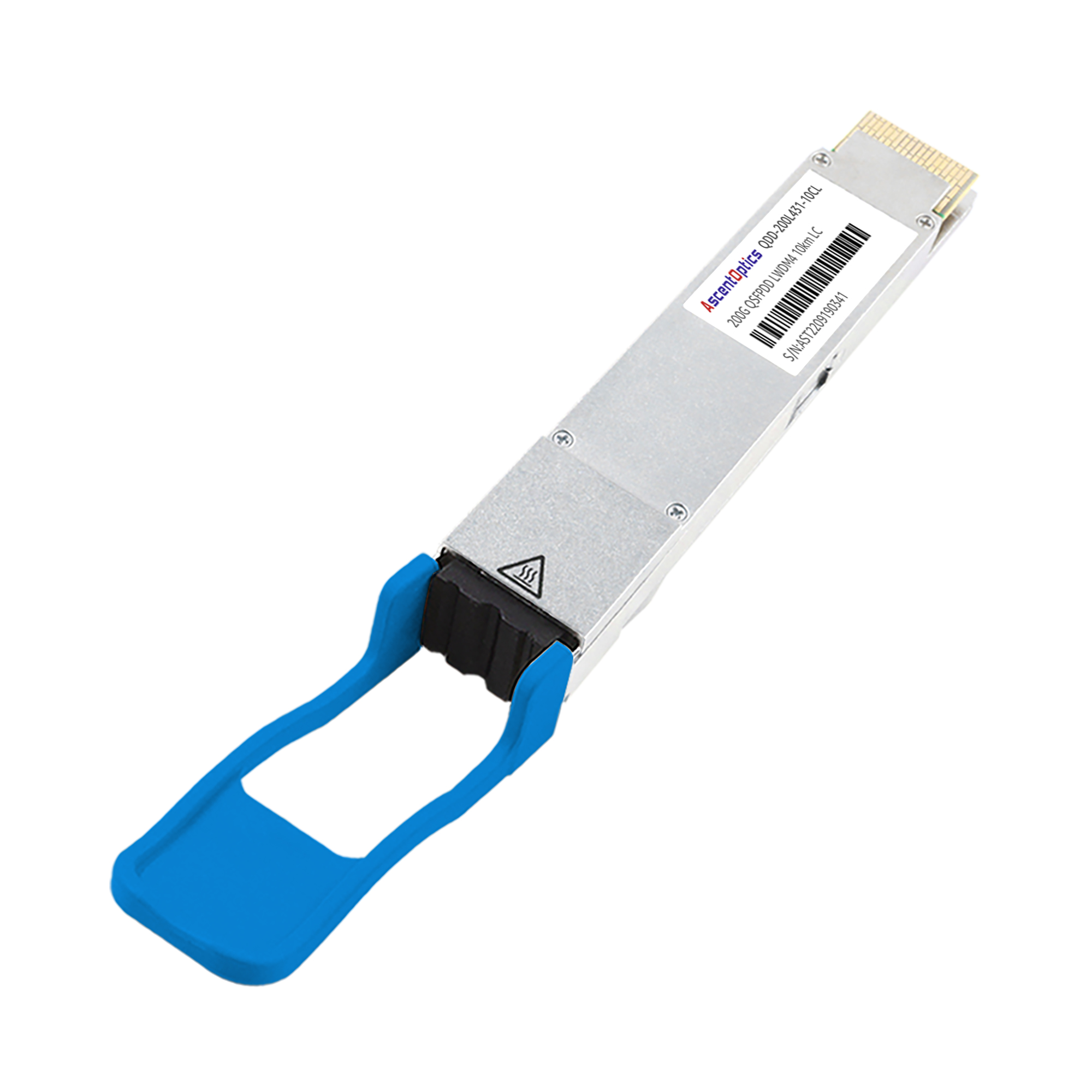The 200G QSFP56 transceiver marks a significant advancement in optical networking technology, substantially increasing data transmission speeds and bandwidth capabilities. This cutting-edge transceiver is designed to meet the escalating demands of data centers and high-performance computing environments, facilitating faster and more efficient data transfer rates. It supports 200 Gbps bandwidth, leveraging PAM4 modulation technology to enhance signal integrity and double the data rate transfer capability compared to its predecessors. The QSFP56 form factor maintains compatibility with existing QSFP ports, ensuring a seamless integration into current network infrastructure while paving the way for future scalability and network evolution.

As cloud computing, 5G, and AI workloads grow, 200G transceivers provide a balance of speed, scalability, and efficiency. They bridge the gap between 100G and 400G, enabling data centers and enterprises to upgrade networks cost-effectively while meeting performance demands. Their compact size and compatibility make them critical for modern infrastructure.
QSFP56 stands for Quad Small Form Factor Pluggable 56, hinting at its capability to support four channels of electrical signals. Each channel can transmit data at up to 50 Gbps using PAM4 modulation, culminating in a total bandwidth of 200 Gbps. This represents a significant leap forward in data transfer technology, primarily due to employing more advanced modulation techniques that enable higher data rate transmission over the same physical infrastructure. QSFP56 transceivers facilitate a marked increase in throughput and efficiency in data centers and high-performance computing environments by doubling the data rate per channel compared to earlier technologies.
The predecessor, QSFP28, supports data rates of up to 100 Gbps, facilitated by four channels running at 25 Gbps each. The QSFP56 enhances this by offering double the bandwidth – 200 Gbps, achieved through doubling the data rate per channel to 50 Gbps. The transition from QSFP28 to QSFP56 encapsulates a move from NRZ (Non-Return to Zero) to PAM4 (Pulse Amplitude Modulation 4 levels) modulation, which is instrumental in this enhancement. This shift increases data throughput and does so without requiring more fiber links, enabling more data to be transferred over the same physical cabling infrastructure and optimizing existing network assets.
By integrating QSFP56 modules into network environments, organizations can significantly bolster their data transmission rates and bandwidth without sacrificing energy efficiency or compatibility with existing infrastructure. The technical advancements embodied in QSFP56 transceivers represent a leap in optical networking, setting a new standard for data transmission capability in demanding computing contexts.

The demand for higher bandwidth in data centers and telecommunications has driven the development of 200G optical transceivers, with QSFP56 and QSFP-DD emerging as key form factors. QSFP56 (Quad Small Form-factor Pluggable 56) supports 200G via four lanes at 50G each, leveraging PAM4 modulation. QSFP-DD (Double Density) doubles the lane count to eight, offering flexibility for both 200G and 400G applications. Both are designed for high-speed Ethernet and InfiniBand, but their differences in design and capabilities cater to distinct needs.
The technical comparison of QSFP56 and QSFP-DD:
QSFP56 maintains the same physical size as QSFP28, using a 38-pin connector for four lanes, optimizing for space-constrained environments. QSFP-DD, with a 76-pin connector, doubles the lane count, supporting higher density but requiring compatible hardware. QSFP-DD’s design allows for greater port density in switches, making it ideal for hyperscale data centers.
QSFP-DD modules have a slightly more significant form factor than QSFP56. This difference is due to the QSFP-DD’s design accommodating more electrical contacts to support the doubled number of lanes. The increased size could be a consideration in densely packed systems where space is at a premium.
QSFP56 relies on PAM4 (Pulse Amplitude Modulation 4-level) to achieve 50G per lane, doubling data rates compared to NRZ (Non-Return-to-Zero) used in older QSFP modules. QSFP-DD also uses PAM4 for 200G configurations but can support NRZ for backward compatibility. PAM4’s complexity increases signal processing demands but enables higher bandwidth within the same physical constraints.
The QSFP56’s 38-pin interface supports four electrical lanes, aligning with 200G requirements. QSFP-DD’s 76-pin interface doubles this to eight lanes, providing flexibility for 200G or 400G via lane configuration. This makes QSFP-DD more future-proof but requires advanced PCB designs to handle the denser interface.
QSFP56 delivers 200G using four 50G lanes, suitable for applications needing moderate bandwidth. QSFP-DD can operate at 200G with four 50G lanes or scale to 400G with eight 50G lanes, offering greater flexibility. The choice depends on whether the priority is immediate bandwidth or long-term scalability.
QSFP56 transceivers typically consume less power (around 7-10W) due to fewer lanes, making them suitable for energy-sensitive deployments. QSFP-DD modules, supporting more lanes, can consume up to 12-15W for 200G configurations, requiring robust cooling systems. Efficient thermal management is critical for both in high-density racks.
While QSFP56 modules are designed to maintain or improve upon the power efficiency of their predecessors, QSFP-DD modules, owing to their higher bandwidth capabilities, may exhibit higher power consumption. Considering the trade-off between speed and power efficiency is vital based on your network’s specific requirements.
Both QSFP56 and QSFP-DD support 200G Ethernet and InfiniBand HDR, with QSFP56 optimized for four-lane configurations and QSFP-DD offering dual-mode (200G/400G) flexibility. QSFP-DD’s higher lane count reduces latency in high-density setups, while QSFP56 provides stable performance for simpler networks. QSFP-DD stands out for its higher forward compatibility. The QSFP-DD’s design allows for backward compatibility with QSFP, QSFP+, QSFP28, and QSFP56 modules, providing a seamless upgrade path without necessitating a complete overhaul of the existing setup.
QSFP56 is a cost-effective upgrade solution that significantly enhances performance while maintaining high compatibility and energy efficiency. On the other hand, QSFP-DD modules offer a path to achieve maximum speed and bandwidth, which is critical for environments with extremely high data throughput demands. The choice between these two modules should depend on both current and future network requirements.
QSFP56 modules are well-suited for data centers and high-performance computing environments that require high, but not extreme, data transmission speeds. In contrast, QSFP-DD modules are specifically designed for ultra-high-speed data environments where maximizing bandwidth and data throughput is critical.

QSFP56 is widely used in intra-data center connections, supporting high-speed interconnects for servers and storage. QSFP-DD excels in hyperscale data centers and HPC environments, where its higher density and scalability support massive parallel computing and AI workloads. 200G QSFP56 modules serve as high-speed interlinks between switches, routers, and servers in data centers, facilitating the rapid transfer of large volumes of data essential for cloud computing, big data analytics, and storage networks.
In 5G fronthaul and backhaul, QSFP56 provides cost-effective 200G connectivity for base stations. QSFP-DD’s higher capacity suits core network aggregation, where scalability to 400G is a future consideration. Both ensure low-latency, high-throughput performance critical for 5G.
QSFP56 is ideal for enterprise networks upgrading from 100G, offering simplicity and cost savings. QSFP-DD is preferred by cloud providers needing dense, scalable infrastructure to handle growing traffic. Both support Ethernet and InfiniBand, catering to diverse enterprise needs.
QSFP56 and QSFP-DD support both single-mode fiber (SMF) for long distances and multi-mode fiber (MMF) for short-reach applications. MMF is cost-effective for intra-rack connections, while SMF supports inter-building or metro links, with range varying by module type.
QSFP56 SR4 (Short Range) uses MMF for up to 100m at 200G, ideal for data center racks. QSFP56 FR4 (Fiber Reach) uses SMF for up to 2km, suitable for campus networks. Both leverage PAM4 for efficient bandwidth. QSFP-DD LR4 (Long Reach) supports SMF up to 10km, while ER4 (Extended Reach) extends to 40km, catering to metro and regional networks. These modules are designed for high-capacity links where distance is critical.

When considering the integration of 200G QSFP56 modules into your network, choosing between optical and copper solutions is pivotal. Specific use cases and your existing network infrastructure should influence it.
The primary distinction between optical and copper QSFP56 lies in their transmission medium and range. Optical QSFP56 modules employ fiber optic cables to transmit data over longer distances with minimal signal loss. They are ideal for inter-building connections or within large data centers requiring high-speed connections over considerable distances. On the other hand, copper QSFP56 solutions, utilizing direct attach cables (DACs), are best suited for short-range connections, such as within the same rack or in closely situated equipment, offering a cost-effective, low-power alternative for shorter data transmission paths.
Deploying QSFP56 to 4x SFP56 Direct Attach Copper (DAC) breakout cables significantly enhances network flexibility and operational efficiency. This solution enables a single QSFP56 port to connect with up to four SFP56 devices, effectively quadrupling connectivity options without additional hardware. Here are the technical advantages of using QSFP56 breakout cables:
To ensure the successful deployment of QSFP56 to 4x SFP56 DAC breakout cables, consider the following tips and best practices:
By understanding and leveraging the technical advantages of QSFP56 to 4x SFP56 DAC breakout cables, organizations can achieve a highly flexible, efficient, and cost-effective network infrastructure prepared for future demands.

The evolution from QSFP28 to QSFP56 modules represents a significant leap forward in data transmission capabilities, primarily aimed at accommodating the escalating demands for bandwidth in modern data centers. QSFP28 modules, designed for 100G networking, encompass many applications but hit their bandwidth ceiling at 100Gbps. QSFP56 modules, on the other hand, double this capacity to 200Gbps by utilizing four lanes, each lane capable of transmitting 50Gbps. This advancement boosts network efficiency and supports higher-density configurations, optimizing space and power usage in data centers. The transition to QSFP56 is pivotal for organizations looking to future-proof their networks in line with growing data demands.
PAM4 (Pulse Amplitude Modulation with four levels) modulation plays a crucial role in the enhanced capabilities of QSFP56 modules. While traditional binary modulation transmits data using two states (0 and 1), PAM4 doubles the data rate by employing four amplitude levels, allowing two bits of data to be transmitted simultaneously. This means QSFP56 modules, leveraging PAM4 modulation, substantially upgrade data transmission speeds and efficiency. For data centers, adopting PAM4 indicates significantly improved bandwidth and performance without necessitating an overhaul of existing physical infrastructure. Essentially, PAM4 complements the push towards 200G Ethernet, allowing data centers to manage more data traffic while maintaining high-performance levels.
The emergence of 200G Ethernet with QSFP56 transceivers opens up new possibilities for network expansion beyond traditional uses. These modules drive high-speed connections for cloud computing, HPC, and data storage, optimizing data processing. In InfiniBand systems, QSFP56 transceivers boost data rates, which is crucial for supercomputing. Overall, QSFP56’s PAM4 modulation is a significant step in meeting modern data center demands, significantly enhancing network performance.

A: A 200G QSFP56 transceiver is a high-speed, pluggable optical module used to transmit and receive data at a rate of 200Gbps in data center networking applications.
A: The key features of 200G QSFP56 transceivers include a compact QSFP form factor, compliance with IEEE standards, support for 200G data rates, and compatibility with various connector types such as LC and MPO.
A: 200G QSFP56 transceivers offer double the data rate compared to 100G QSFP transceivers, allowing for increased bandwidth and faster transmission speeds in cloud data center environments.
A: 200G QSFP56 transceivers support a wide range of cables, including direct attach copper (DAC) cables, optical transceivers, cable assemblies, and copper cables with duplex LC connectors.
A: 200G QSFP56 transceivers are designed for backward compatibility, enabling seamless integration with existing pluggable modules and interfaces operating at lower speeds such as 50G and 100G.
A: 200G QSFP56 transceivers typically employ non-return-to-zero (NRZ) modulation techniques to encode data for transmission, ensuring reliable and efficient communication over the network.
A: 200G QSFP56 transceivers are widely deployed in data centers to connect networking equipment, servers, and storage devices, enabling high-speed data transfer, low-latency communication, and efficient network operations.
Recommended Reading :The Differences Between SFP, SFP+, SFP28 vs QSFP28 Transceivers: Compatibility and Performance